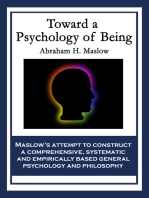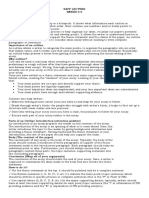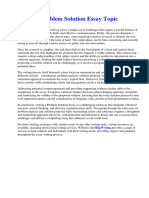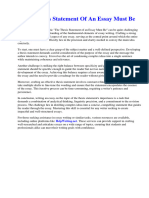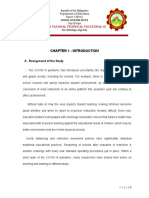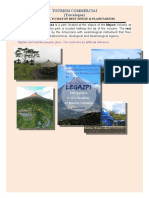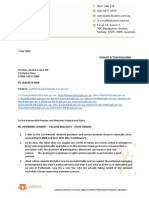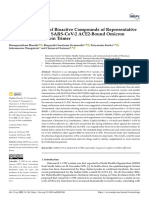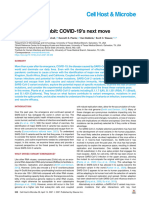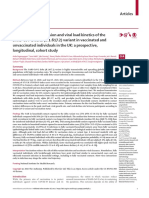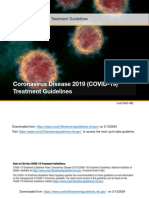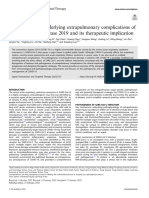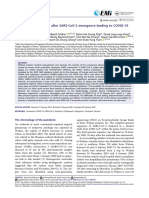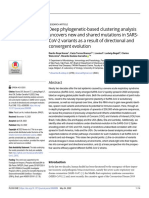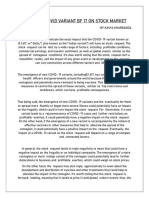Samples of Academic Texts
Uploaded by
Gwyneth BuenconsejoSamples of Academic Texts
Uploaded by
Gwyneth BuenconsejoPage |1
Samples of Academic Texts
Compiled by:
Gwyneth L. Buenconsejo
Page |1
Table of Contents
Introduction…………………………………………...1
Essay…………………………………….....................2
Reaction Paper………………………………………..3
Concept Paper ………………………………………..4
Position paper……………………………………….5-7
Research……………………………………………...8-9
Report.....................................................................10
Page |1
Introduction
Academic texts are written for professional audience or persons specializing in a
specific field. It is also defined as critical, objective, specialized texts written by experts or
professionals in a given field using formal language. In contrast, Non-Academic texts are
written for the mass public. They are published quickly and can be written by anyone. Their
language is informal, casual and may contain slang. The author may not be provided and will
not have any credentials list.
There are six general classifications of academic texts used for different purposes. Essay is
generally the preform for all analytical compositions. However, not all essays are academic.
Only those that are written for professional audience and exhibit formal tone in subject matter,
sentence structure, and language can be considered academic. Concept paper defines an idea
or a concept and clarifies its ‘whatness’; thus, its most prominent structure is the use of
definition. Reaction paper is generally an informed and insightful perspective on art, popular
culture, and a technical topic. Position paper asserts an argument. Report retells data,
incident, or an event. Research is highly formal kind of reports.
The three-part essay structure is a basic structure that consists of introduction, body and
conclusion. The introduction and the conclusion should be shorter than the body of the text.
For shorter essays, one or two paragraphs for each of these sections can be appropriate.
Academic achievement is important for the successful development of young people in
society. Students who do well in school are better able to make the transition into adulthood and
to achieve occupational and economic success.
Page |1
Ideal Social Moral Code
Upon reflection of the ideal social moral code, within one sentence, it would be: be constructive,
not destructive. We have many holy books, manuals on living, and self-help tomes. However, I feel
this is the most exacting moral code in terms of a social context. By social context, I mean how we
interact with others and behave in social situations. Though “be constructive, not destructive” sounds
sensible, there are many nuances. Sometimes it is difficult to determine if an act is exactly
constructive or destructive. In the following paragraphs, these nuances will be discussed in detail.
We can decide if something is constructive or destructive based on degree, for instance. Say your
toddler son is acting up and broke a glass vase, even after you told him to stop grabbing and playing
with it several times. You get a thought in your mind to spank him to give a punishment for his naughty
action. However, you start to feel confused about whether this would be constructive or destructive. It
might show him that not listening to you and breaking fragile things is not welcome, but on the other
hand, spanking him is an act of aggression that will hurt him physically and perhaps teach him to use
force in situations later in life. There is no exact wrong or right in these moments. However, through
your own reasoning, you can decide to what degree it would be beneficial or harmful to him and the
situation at hand. Personally, I would not spank my son, as I think it does more destruction than
construction. But, that is just me.
Another nuance to consider is the definition we give to construction and destruction. For example,
for some people, construction can never involve violence, while for others, it could even be an integral
part of the equation. Take the example of going back in time and killing Hitler. Killing someone is
definitely termed a destructive act. However, in light of the circumstances, I would assume that the
majority of people would agree that killing Hitler at the height of his power if they had the chance
would be seen as a constructive, thus positive act. Therefore, our definitions often determine our
values and how we behave upon those principles.
Additionally, construction and destruction can be filtered through a socio-political lens.
Construction can be seen as good to some, and bad to others. Take for instance creating new homes
in a forested area. Yes, homes for humans are made, but also the habitat for countless animals is
being destroyed, or at least altered to an extreme. Construction, if it is true, it should be beneficial to
all parties included. That is a tall order, though. Every step we take kills bacteria and other
microorganisms—and perhaps plants, insects, and who knows what else. Destruction can be seen as
a part of each moment. Plus, what a majority might perceive as a constructive might be seen as
destructive to a minority.
Is there a way to determine which side is correct? It is almost impossible. Being in the majority in
terms of a moral outlook does not mean it is correct, or more appropriate. There have been many
instances in history when acts were perceived as constructive, but were later seen as destructive with
a modern lens. The Crusades, a series of religious wars between mainly Christians and Muslims, were
seen historically in a favorable light in its time by Christians. However, in the latter half of the
Crusades, sentiments about these holy wars were not cheerful among the Christian faithful. And if one
talks about the present view on the Crusades, the majority of Christians will admit that it is a stain in
their history books. So, often history is not kind to the perceptions we once held.
Though I consider “Be constructive, not destructive” the most solid one-sentence social moral
code, it it not without its nuances and conundrums. For instance, the degree to which we consider
something constructive or destructive, definitions of being constructive and destructive, and
construction and destruction seen through a sociopolitical lens are all nuances. These discrepancies
comprise the confusion that this ideal social moral code engenders. However, I cannot imagine a
better code than the one stated in this essay in terms of living one’s life in a social context.
Source: https://academichelp.net/samples/academics/essays/reflective/ideal-social-moral-code.html
Page |1
Reaction Paper on the Film “A Beautiful Mind”
A Beautiful Mind is a movie about John Forbes Nash Jr. who is notable for his
contributions in Economics and Mathematics. It was evident in the film that he has an
outstanding talent and showed it by performing at a remarkably high level of
accomplishment. With a superior intelligence, I can say that Nash is truly a brilliant man.
Despite the fact he is a genius, everything still wasn't perfect -- he's suffering
from a mental illness called schizophrenia without his awareness. While he has a
beyond average aptitude in logical and mathematical aspects, he had problems with his
interpersonal relationships. This affliction slowly eats up his mind, destroying his bond
with the people around him. With this illness, he wasn't able to separate the imaginary
world from the real world he is living in, with all the hallucinations and nonexistent
friends he has.
I strongly believe that these delusions are from the feelings and memories he
repressed in his subconscious that liberates in the form of imaginary friends and such.
Lucky for him that he has understanding wife, because if it wasn't for her love and
support, he wouldn't be able to get through one of the hardest trials in his life. Although
she nearly lost her faith, Alicia didn't give up the hope that Nash will someday overcome
his disease. This quality of Alicia is something I admired: standing by and staying
committed to the person she loves the most.
Granted all the struggles, Nash didn't give up the passion to learn and share his
learning’s as well. He came out on top of this illness by declining therapy, living a
normal life with Alicia and his child, and also by persisting in educating eager young
minds.
After watching this film, I am in stack of awe with the way Nash conquered
everything that stood in the way for achieving his dreams. I guess, the learning we can
take from his story is that we should see our disabilities not as hindrances rather, as
challenges to make us strive for more. There may be times that we trip a little, we may
even fall, but we must stand up and continue walking towards fulfilling our goals.
Source: Reaction Paper on the Film “A Beautiful Mind”. (2016, Aug 25). Retrieved
fromhttps://phdessay.com/reaction-paper-on-the-film-a-beautiful-mind/
Page |1
Concept Paper on Culture
by: mjiepdanganan
Culture. What defines culture by the way? Culture refers to the cumulative deposit
of knowledge, experience, beliefs, values, attitudes, meanings, hierarchies, religion,
notions of time, roles, spatial relations, concepts of the universe, and material objects and
possessions acquired by a group of people in the course of generations through
individual and group striving. The meaning says it all. But, as for me, culture is
communication, and communication is culture. It is something, or either one way of
expressing the lifestyle or the way of living of a certain group of people. Culture is more
likely a language, where all people who are involved with it understand each other,
because they are used to it for a long period of time.
I came from the province of Pampanga, a province located in the Central Luzon,
as my parents do too. And of course, all things there captures my mind, but one thing
captured me the most, and that is the culture of the province. One significant, remarkable
sign of Pampanga is having nice people who has the ability to cook unique food, or
dishes rather, deliciously imponderable. And because of that, Pampanga is known as the
“Culinary Capital of the Philippines”. And it is so much fun hearing about that, that many
tourist was attracted to visit the province for their remarkable cooking.
As I’ve said earlier, my parents came from Pampanga, so it is not that surprising that they
know some of the cultures of the province. One of those is the celebration of the Lenten
Season. My family, occasionally attend the so called “Pabasa” during the Lenten season,
and it is done every year. This practice of our family has been a great activity for us
because it strengthens our religious belief stronger as we do it with the whole faith of our
family.
Culture makes people have the unity to understand each other, and to share it with others
to make their selves clearly understandable. Culture is some other way of communicating
by means of different strategic based activity where people are raised to and used to that
culture. Culture is very important, especially, for the next generation of ours, for it will
become a remark from where their practicing culture all begun.
Source: https://www.termpaperwarehouse.com/essay-on/Concept-Paper-On-Culture/332641
Page |1
Position Paper on the use of blended learning in initial qualification
and periodic training of professional drivers according to directive
2003/59/EC
EU directive 2003/59/EC on the initial qualification and periodic training of
drivers of certain road vehicles for the carriage of goods or passengers does not prohibit
the use of e-learning. Some EU Member States have in their implementation of the
directive in national law, provided for the possibility to pass parts of the periodic training
of professional drivers via elearning units. Austria even allows for entire modules to be
taken with e-learning methods.
In MOVING’s point of view, the implementation with a blended learning
approach is more expedient and efficient than e-learning alone. Blended Learning is a
combination of autonomous, media-assisted learning (e-learning) and classical
presence based classroom teaching. The goal of blended learning techniques is to
combine the advantages of face-to-face teaching with entirely digital e-learning units
and to avoid the disadvantages of both methods.
Blended learning supplements phases of students learning independently using their
smartphone, computer or tablet with face-to-face teaching. In class, after having
examined the individual progress of each student, the instructor can discuss contents
which have proven difficult, answer questions and teach topics which are better
conveyed in person. For this reason, blended learning has several advantages over
simple e-learning:
The connection and motivation of students is higher when they learn as part of a
social group under the supervision of an instructor, instead of studying alone at home.
This way, significantly lower drop-out rates have been observed. Furthermore, the
exchange with other students and the possibility to ask questions on the material in an
informal setting are advantageous to the learning process.
The coupling of autonomous learning units and mandatory class sessions gradually
teaches the participants important competences like discipline, time management, self-
motivation and the capacity to study on their own. Nevertheless, the student does not
carry the entire responsibility for his success by himself but is supported and supervised
by a teacher, just like in a traditional class room setting.
Some topics are better taught in class or with study groups, for example practical
exercises on cargo securing or communication. Other contents are more easily display
digitally, such as models of processes, dates and facts or technical proceedings. Those
topics can be studied more easily with the e-learning method, via repeated exercises.
The combination of both methods assures that each subject can be taught with the
appropriate technique.
Page |1
Studying becomes more individual: the students can learn in a more flexible way,
independent of time and place, at their own pace. During the classroom phase, they
then have the opportunity to ask specific, individual questions since the instructor
teaches and revises problematic content.
For these reasons, the method of blended learning is especially apt for
recurring employee training such as continuing training for professional drivers or
training on workplace safety. Since a majority of participants is already familiar with the
topic, they can easily work with a media-based format at their own pace. Nevertheless,
the instructor can still point out frequent mistakes and discuss them with all participants.
Therefore, the use of blended learning would be recommendable in continuing training
for professional drivers. With the use of blended learning concepts, the efficacy and
economic efficiency of training and continued education can be improved. However, in
order to actually raise efficiency and avoid abuse, the coupling of e-learning elements
with classroom teaching units under the direction of a training centre is indispensable.
Therefore, MOVING supports measures trying to introduce or establish
blended leaning, e.g. in training elements according to EC/2003/59. In order to reach its
full potential and to avoid abuse that could be created with the use of purely digital
teaching units without combination with classroom phases, MOVING favors the
blended-learning concept developed above, where the instructor can at any moment
accompany and review the progress of each participant and consequently adapt their
training. This is how the desired gains in efficiency and results can be obtained.
Source: https://www.moving-roadsafety.com/wp-content/uploads/2016/05/Position-Paper-on-
blended-learning.pdf
Page |1
A systematic review: the influence of social media on
depression, anxiety and psychological distress in
adolescents
The World Health Organization (WHO, 2017) reported that 10–20% of children
and adolescents worldwide experience mental health problems. It is estimated that 50%
of all mental disorders are established by the age of 14 and 75% by the age of 18
(Kessler et al., 2007; Kim-Cohen et al., 2003). The most common disorders in children
and adolescents are generalized anxiety disorder and depression, respectively (Mental
Health Foundation, 2018; Stansfeld et al., 2016).
According to the Royal Society for Public Health, & Young Health Movement
(2017), the prevalence of anxiety and depression has increased by 70% in the past 25
years in young people. Depression and anxiety have adverse consequences on
adolescent development, including lower educational attainment, school dropout,
impaired social relationships, and increased risk of substance abuse, mental health
problems and suicide (Copeland, Angold, Shanahan, & Costello, 2014; Gore et
al., 2011; Hetrick, Cox, Witt, Bir, & Merry, 2016). Morgan et al. (2017) reported that the
rate of self-harm in the UK has risen by 68% in girls aged 13–16 over the last 10 years.
Reasons for the apparently growing psychological morbidity in young people are
not known conclusively. McCrae (2018) suggests that diagnostic activity has been
influenced by educational initiatives to raise mental health awareness. Undeterred by
stigma, many young people feel free to discuss their psychological difficulties and seek
professional help.
Another important factor is the ease of sharing personal experiences in the digital
information age (Reid-Chassiakos, Radesky, Christakis, & Moreno, 2016). Whereas in
the past mental health problems were suffered in isolation, today a struggling younger
person can readily find others with similar problems, either through social interaction or
support groups. Alongside increasing awareness and help-seeking behaviour, doctors
may be more inclined to diagnose and treat mental health problems, possibly with the
effect of lowering the diagnostic threshold.
Impact on mental health
Understanding the impact of social media on adolescents’ well-being has
become a priority due to a simultaneous increase in mental health problems
(Kim, 2017). Problematic behaviours related to internet use are often described in
psychiatric terminology, such as ‘addiction’. However, some activity in younger people
could be misconstrued as abnormal. For example, young people who frequently post
images of themselves (‘selfies’) may appear narcissistic, but such behaviour has
emerged as a social norm in younger social networks (McCrae, 2018). Nonetheless,
warnings have been issued by psychologists and other experts on how younger people
Page |1
are engaging with social media and related impairment to personal and social
development (Greenfield, 2014; Twenge, 2006).
Social media could be regarded as a ‘double-edged sword’. Studies show the
benefits of enabling people to express their thoughts and feelings, and to receive social
support (Deters & Mehl, 2013; Lenhart et al., 2015; Lilley, Ball, & Vernon, 2014;
O’Keeffe & Clarke-Pearson, 2011; Rosen, 2011). Research has also indicated a link
between social media use and psychological problems. A systematic review of 11
studies measuring social media use and depressive symptoms in children and
adolescents showed a small but statistically significant relationship (McCrae, Gettings,
& Purssell, 2017. The link between social media and mental health problems is not
straightforward, with various contributory factors. A report by the Royal Society for
Public Health, & Young Health Movement (2017) suggested impaired sleep as a
mechanism. Internet use is a sedentary behaviour, which in excess raises the risk of
health problems (Iannotti et al., 2009).
Studies support that those with low social support are more likely to suffer from
mental health problems (e.g. depression, anxiety and psychological distress) compared
to those with high social support from family, friends and neighbours (Klineberg et
al., 2006; Maulik, Eaton, & Bradshaw, 2011). Reviewing 70 studies, Seabrook, Kern,
and Rickard (2016) found an inverse correlation between supportive online interaction
on social media and both depression and anxiety. However, as some researchers (e.g.
Teo, Choi, & Valenstein, 2013; Vandervoort, 1999) have indicated, the quality of social
support may be more important than quantity.
As explained by social comparison theory (Festinger, 1954), people tend to
compare themselves to others to assess their opinion and abilities. Interestingly, such
behaviour is more common in adolescents than in younger children and adults (Krayer,
Ingledew, & Iphofen, 2008; Myers & Crowther, 2009).
The impact of social media on mental health may differ between adolescents
who engage in downward social comparison (comparing themselves to lower
performers) and those who use higher performers as a reference point. A systematic
review by Seabrook et al. (2016) reported a correlation between negative online
interaction and both depression and anxiety. Similarly, Appel, Gerlach, and Crusius
(2016) found that passive Facebook use predicts social comparison and envy, which in
turn lead to depression.
Much of the research to date has studied young people of later adolescence and
college or university students. Previous systematic reviews included more studies since
they have either focused on a heterogeneous population including children, adolescents
and adults (Baker & Algorta, 2016; Marino et al., 2018; Seabrook et al., 2016) or
focused on general mental well-being including both clinical outcomes and subjective
well-being as the outcome of interest (Best et al., 2014; Marino et al., 2018).
Source: Betul Keles, Niall McCrae & Annmarie Grealish (2020) A systematic review: the
influence of social media on depression, anxiety and psychological distress in
adolescents, International Journal of Adolescence and Youth, 25:1, 79-
93, DOI: 10.1080/02673843.2019.1590851
Page |1
Philippines reports first Brazil COVID variant as
new cases surge
The Philippines has detected its first case of the highly contagious coronavirus
variant first identified in Brazil, the health department said, as the number of infections
surges to the highest level in six months. A Filipino returning from Brazil tested positive
for the P.1 variant after 752 samples were sequenced at the genome center, the
department said in a statement on Saturday.
It reported 59 new infections of the B.1.1.7 variant first detected in the United Kingdom,
and 32 cases of the B.1.351 variant discovered in South Africa. This brings cases for
those variants to 177 and 90, respectively.
“Correct and consistent adherence to the minimum public health standards will prevent
the transmission of these variants,” the department said. The department also reported
13 cases “with mutations of possible clinical significance”.
The Philippines, which has the second-highest number of COVID-19 cases and
deaths in Southeast Asia, is battling a renewed surge as it ramps up a vaccination drive
that started on March 1.
On Friday, the country reported 4,578 new coronavirus infections, the biggest daily
increase in cases in nearly six months.
That brings the total number of confirmed cases to 611,618. The number of deaths
reached 12,694, with 87 fatalities added. The renewed surge in COVID-19 cases has
prompted mayors in the capital, Manila, an urban sprawl of 16 cities, to impose an
evening curfew until the end of March and remind the public to practice physical
distancing.
The latest developments also come as Japanese health officials reported on Friday a
new COVID-19 variant in a traveller from the Philippines.
Japan’s National Institute of Infectious Diseases (NIID) said that the person’s
coronavirus sample tested positive for E484K and N501Y mutations.
“The variant is distinct from those first discovered in Britain, South Africa and Brazil, and
is thought to pose a similar level of threat,” Kyodo news agency was quoted as saying.
Source: Al Jazeera and News Agencies https://www.aljazeera.com/news/2021/3/13/philippines-
reports-first-brazil-covid-variant-as-new-cases
Page |1
You might also like
- English For Academic and Professional Purposes: Quarter 1100% (1)English For Academic and Professional Purposes: Quarter 122 pages
- Understanding Stupidity by James F Welles PH D100% (1)Understanding Stupidity by James F Welles PH D153 pages
- Q4 L6 Writing A Balanced Review, Reaction, and Critique Paper0% (1)Q4 L6 Writing A Balanced Review, Reaction, and Critique Paper36 pages
- Toward a Psychology of Being (Rediscovered Books): With linked Table of ContentsFrom EverandToward a Psychology of Being (Rediscovered Books): With linked Table of ContentsNo ratings yet
- 2 Eapp (Aspects of Professional - Academic Language)0% (1)2 Eapp (Aspects of Professional - Academic Language)59 pages
- English For Academic and Professional Purposes: Module 4 - Quarter 150% (4)English For Academic and Professional Purposes: Module 4 - Quarter 15 pages
- Why and How Concept Papers Can Contribute To Society: More - HorizNo ratings yetWhy and How Concept Papers Can Contribute To Society: More - Horiz3 pages
- Eapp Lecture WEEKS 5-6 Quarter 1 - Module 5: What Is An Outline?No ratings yetEapp Lecture WEEKS 5-6 Quarter 1 - Module 5: What Is An Outline?5 pages
- Language and Text Structure Across DisciplinesNo ratings yetLanguage and Text Structure Across Disciplines7 pages
- Sociologica L Criticism: Jovel Crizia G. Taasan Bjorn Russel C. LemeryNo ratings yetSociologica L Criticism: Jovel Crizia G. Taasan Bjorn Russel C. Lemery17 pages
- So What Are The Similarities and Differences Among Review, Reaction and Critique Paper?No ratings yetSo What Are The Similarities and Differences Among Review, Reaction and Critique Paper?20 pages
- How To Get Out Of Work: A Framework For Manipulation, Deception, And MisdirectionFrom EverandHow To Get Out Of Work: A Framework For Manipulation, Deception, And MisdirectionNo ratings yet
- The Science of Social Intelligence: 45 Methods to Captivate People, Make a Powerful Impression, and Subconsciously Trigger Social Status and ValueFrom EverandThe Science of Social Intelligence: 45 Methods to Captivate People, Make a Powerful Impression, and Subconsciously Trigger Social Status and Value4.5/5 (4)
- INSTINCTS OF THE HERD IN PEACE AND WAR: Exploring the Dynamics of Collective Behavior in Times of Stability and Conflict (2024 Guide for Beginners)From EverandINSTINCTS OF THE HERD IN PEACE AND WAR: Exploring the Dynamics of Collective Behavior in Times of Stability and Conflict (2024 Guide for Beginners)No ratings yet
- Meet Your Political Mind: The Interactions Between Instincts and Intellect and Its Impact on Human BehaviorFrom EverandMeet Your Political Mind: The Interactions Between Instincts and Intellect and Its Impact on Human BehaviorNo ratings yet
- The Reillusionment: Globalization and the Extinction of the IndividualFrom EverandThe Reillusionment: Globalization and the Extinction of the IndividualNo ratings yet
- Hope and the Future: An Introduction to the Concept of Cultural MaturityFrom EverandHope and the Future: An Introduction to the Concept of Cultural MaturityNo ratings yet
- Interview with political philosopher Michael J. Sandel - Egon ZehnderNo ratings yetInterview with political philosopher Michael J. Sandel - Egon Zehnder7 pages
- The Essence of Being Human: A Repository of Human Relations EnlightenmentFrom EverandThe Essence of Being Human: A Repository of Human Relations EnlightenmentNo ratings yet
- SocialConstruction RevolutionInTheMakeingNo ratings yetSocialConstruction RevolutionInTheMakeing30 pages
- Chapter 1 - Introduction: A. Background of The StudyNo ratings yetChapter 1 - Introduction: A. Background of The Study14 pages
- Chapter 1 - Introduction: A. Background of The StudyNo ratings yetChapter 1 - Introduction: A. Background of The Study45 pages
- Rinconada National Technical Vocational School: Region V - (Bicol) City of IrigaNo ratings yetRinconada National Technical Vocational School: Region V - (Bicol) City of Iriga4 pages
- CHAPTER II REVIEW OF RELATED LITERATURE This Chapter Presents Four Topics Related To The StudyNo ratings yetCHAPTER II REVIEW OF RELATED LITERATURE This Chapter Presents Four Topics Related To The Study7 pages
- Technical Brief and Priority Action On OmicronNo ratings yetTechnical Brief and Priority Action On Omicron8 pages
- BioNTech SE, Q2 2024 Earnings Call, Aug 05, 2024 - 1No ratings yetBioNTech SE, Q2 2024 Earnings Call, Aug 05, 2024 - 120 pages
- Wilson Sy - Excess Deaths in The United Kingdom-Midazolam and Euthanasia in The Covid19 PandemicNo ratings yetWilson Sy - Excess Deaths in The United Kingdom-Midazolam and Euthanasia in The Covid19 Pandemic22 pages
- Sars-Cov-2 Variant of Concern Omicron: Update OnNo ratings yetSars-Cov-2 Variant of Concern Omicron: Update On24 pages
- WHO 2019 NCoV Clinical 2023.2 Eng 2 CompressedNo ratings yetWHO 2019 NCoV Clinical 2023.2 Eng 2 Compressed186 pages
- The Mechanism Underlying Extrapulmonary Complications of The Coronavirus Disease 2019 and Its Therapeutic ImplicationNo ratings yetThe Mechanism Underlying Extrapulmonary Complications of The Coronavirus Disease 2019 and Its Therapeutic Implication33 pages
- Rapid Generation of Potent Antibodies by Autonomous Hypermutation in YeastNo ratings yetRapid Generation of Potent Antibodies by Autonomous Hypermutation in Yeast26 pages
- Deep Phylogenetic-Based Clustering Analysis Uncovers New and Shared Mutations in SARS-CoV-2 Variants As A Result of Directional and Convergent EvolutionNo ratings yetDeep Phylogenetic-Based Clustering Analysis Uncovers New and Shared Mutations in SARS-CoV-2 Variants As A Result of Directional and Convergent Evolution14 pages
- Covid-19_ How Much Herd Immunity is Enough_ - The New York TimesNo ratings yetCovid-19_ How Much Herd Immunity is Enough_ - The New York Times1 page
- Impact of Covid Variant BF 17 On Stock Market 1No ratings yetImpact of Covid Variant BF 17 On Stock Market 13 pages
- Guidance for Discharge and Ending of Isolation of People With COVID 19 Third UpdateNo ratings yetGuidance for Discharge and Ending of Isolation of People With COVID 19 Third Update16 pages
- DDMA Order 490. Dt. 30.11.2021 Reg. International ArrivalsNo ratings yetDDMA Order 490. Dt. 30.11.2021 Reg. International Arrivals6 pages
- English For Academic and Professional Purposes: Quarter 1English For Academic and Professional Purposes: Quarter 1
- Q4 L6 Writing A Balanced Review, Reaction, and Critique PaperQ4 L6 Writing A Balanced Review, Reaction, and Critique Paper
- Toward a Psychology of Being (Rediscovered Books): With linked Table of ContentsFrom EverandToward a Psychology of Being (Rediscovered Books): With linked Table of Contents
- 2 Eapp (Aspects of Professional - Academic Language)2 Eapp (Aspects of Professional - Academic Language)
- English For Academic and Professional Purposes: Module 4 - Quarter 1English For Academic and Professional Purposes: Module 4 - Quarter 1
- Why and How Concept Papers Can Contribute To Society: More - HorizWhy and How Concept Papers Can Contribute To Society: More - Horiz
- Eapp Lecture WEEKS 5-6 Quarter 1 - Module 5: What Is An Outline?Eapp Lecture WEEKS 5-6 Quarter 1 - Module 5: What Is An Outline?
- Sociologica L Criticism: Jovel Crizia G. Taasan Bjorn Russel C. LemerySociologica L Criticism: Jovel Crizia G. Taasan Bjorn Russel C. Lemery
- So What Are The Similarities and Differences Among Review, Reaction and Critique Paper?So What Are The Similarities and Differences Among Review, Reaction and Critique Paper?
- How To Get Out Of Work: A Framework For Manipulation, Deception, And MisdirectionFrom EverandHow To Get Out Of Work: A Framework For Manipulation, Deception, And Misdirection
- The Science of Social Intelligence: 45 Methods to Captivate People, Make a Powerful Impression, and Subconsciously Trigger Social Status and ValueFrom EverandThe Science of Social Intelligence: 45 Methods to Captivate People, Make a Powerful Impression, and Subconsciously Trigger Social Status and Value
- INSTINCTS OF THE HERD IN PEACE AND WAR: Exploring the Dynamics of Collective Behavior in Times of Stability and Conflict (2024 Guide for Beginners)From EverandINSTINCTS OF THE HERD IN PEACE AND WAR: Exploring the Dynamics of Collective Behavior in Times of Stability and Conflict (2024 Guide for Beginners)
- Meet Your Political Mind: The Interactions Between Instincts and Intellect and Its Impact on Human BehaviorFrom EverandMeet Your Political Mind: The Interactions Between Instincts and Intellect and Its Impact on Human Behavior
- The Reillusionment: Globalization and the Extinction of the IndividualFrom EverandThe Reillusionment: Globalization and the Extinction of the Individual
- Hope and the Future: An Introduction to the Concept of Cultural MaturityFrom EverandHope and the Future: An Introduction to the Concept of Cultural Maturity
- Interview with political philosopher Michael J. Sandel - Egon ZehnderInterview with political philosopher Michael J. Sandel - Egon Zehnder
- The Essence of Being Human: A Repository of Human Relations EnlightenmentFrom EverandThe Essence of Being Human: A Repository of Human Relations Enlightenment
- Chapter 1 - Introduction: A. Background of The StudyChapter 1 - Introduction: A. Background of The Study
- Chapter 1 - Introduction: A. Background of The StudyChapter 1 - Introduction: A. Background of The Study
- Rinconada National Technical Vocational School: Region V - (Bicol) City of IrigaRinconada National Technical Vocational School: Region V - (Bicol) City of Iriga
- CHAPTER II REVIEW OF RELATED LITERATURE This Chapter Presents Four Topics Related To The StudyCHAPTER II REVIEW OF RELATED LITERATURE This Chapter Presents Four Topics Related To The Study
- BioNTech SE, Q2 2024 Earnings Call, Aug 05, 2024 - 1BioNTech SE, Q2 2024 Earnings Call, Aug 05, 2024 - 1
- Wilson Sy - Excess Deaths in The United Kingdom-Midazolam and Euthanasia in The Covid19 PandemicWilson Sy - Excess Deaths in The United Kingdom-Midazolam and Euthanasia in The Covid19 Pandemic
- The Mechanism Underlying Extrapulmonary Complications of The Coronavirus Disease 2019 and Its Therapeutic ImplicationThe Mechanism Underlying Extrapulmonary Complications of The Coronavirus Disease 2019 and Its Therapeutic Implication
- Rapid Generation of Potent Antibodies by Autonomous Hypermutation in YeastRapid Generation of Potent Antibodies by Autonomous Hypermutation in Yeast
- Deep Phylogenetic-Based Clustering Analysis Uncovers New and Shared Mutations in SARS-CoV-2 Variants As A Result of Directional and Convergent EvolutionDeep Phylogenetic-Based Clustering Analysis Uncovers New and Shared Mutations in SARS-CoV-2 Variants As A Result of Directional and Convergent Evolution
- Covid-19_ How Much Herd Immunity is Enough_ - The New York TimesCovid-19_ How Much Herd Immunity is Enough_ - The New York Times
- Guidance for Discharge and Ending of Isolation of People With COVID 19 Third UpdateGuidance for Discharge and Ending of Isolation of People With COVID 19 Third Update
- DDMA Order 490. Dt. 30.11.2021 Reg. International ArrivalsDDMA Order 490. Dt. 30.11.2021 Reg. International Arrivals



